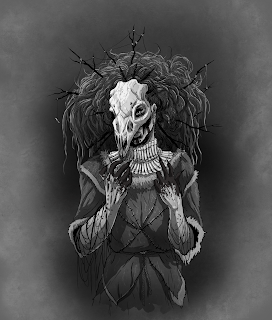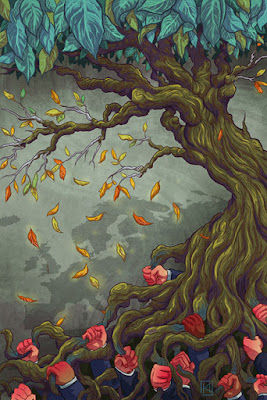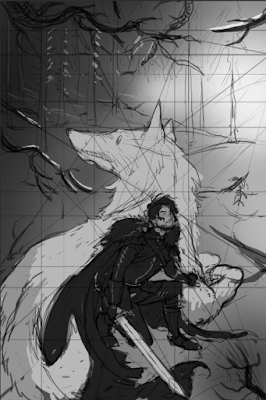This particular person was sincere, and I don't know if it was actually the assignment so much as simply a message of I Need Help.
So I'll provide some things that have helped me personally and this can hopefully work as a FAQ that I can simply link to people to in the future. (I also answer a couple of those assignment questions in the FAQ section on my portfolio site here https://www.kimherbst.com/faq)
- How did you get into illustration as a career (how did you go about getting jobs)?
I got into illustration over the course of many many years after graduating from college. I actually have a career in video games which helps me out financially (and hey this is okay! I don't know too many that do Freelance 100% full-time without teaching or some side job), so I do illustration on the side, either commissions, gigs from companies, or personal projects.
So, first and foremost every illustrator needs a well curated online portfolio. It should only have the best of the best of your pieces in it, usually 8-15ish is a good range. You can find lots of easy templates these days (vs the old days where you'd have to learn to code the site yourself and get lots of headaches...oof). Squarespace, Wordpress etc are great examples - You want the site to strictly be you, vs having something that isn't as curated like DeviantArt, or Tumblr (where someone can see your Favorites, followers, and so many other distracting things from your own work). The portfolio should show what you're capable of, and demonstrate what sort of work you're interested in illustrating for (ie: are you interested in editorials for magazines and newspaper articles? Or children's books? Or comics? etc).
From there, I create a promotional mailer like a postcard, with my name/email/site information on one side and a sample illustration on the other side. I'll get 100-500 cards printed up of the design, and then start to put together a list of addresses of Art Directors who work at places I'd like my work to be in (using a TON of google, as well as looking in physical books/magazines, which will list mastheads in the front, with an Art Director or Creative Director's name, and mailing address for their company). I make sure these companies and publishers are in line with my style of work (ex: I'm not gonna send my more comic/flat-graphic-looking art to a place that likes fully rendered super realistic Sci-Fi style-only art). This is pretty old school, but a lot of art directors still like the mailed postcard method. It's a physical piece of work that they can hold on to, pin over their desk, or keep on hand, compared to simply saving a website URL and forgetting about it. I used to do this a few times a year but now I'm lucky if I get time to do it 1x a year (too busy, too lazy!! Bad work ethic!) Outside of that, cold-emailing places can work, and then simply posting work to social media to get people to see your work and improve over time. I find it helpful to follow other professionals on Twitter or Instagram, they give a ton of insight into building your career from their own experiences.
Some sites that offer more information on this:
https://dearartdirector.tumblr.com/ - Dear Art Director is a group of anonymous art directors who answer Illustration questions, and give honest answers. Incredibly helpful for illustration careers.
https://illustrationdept.com/podcast Illustration Dept podcast - can listen to some in-depth talks with professional illustrators
https://www.hireanillustrator.com/i/ Hire An Illustrator - tons of info on how to hire artists, career advice, what royalties vs advances are, etc etc. This is also a service I've used in the past (paying a yearly or monthly fee) as HAI will send out promotional mailers or emails to potential projects with portfolios that the site runners feel would best suit the project. Tons of example portfolios to peruse through for inspiration, and generally get lots of good ideas/places where you can have your work published.
- Did you find your degree useful when you applied for jobs or were contacted by clients? I have heard conflicting things about getting an art degree.
This is.... tough. I do genuinely feel my degree was immensely helpful, but MICA had classes that greatly prepared me compared to so many other Art institutions at the time. We had a senior year class that was dedicated to portfolio building, and creating the marketing promo material postcards I discussed above, as well as writing Illustration Contracts for jobs, and generally how not to get screwed over by clients. Not many other schools (at least when I graduated in '06) really focused on that, and it was terrifying to hear that, especially with how much higher education is costing these days. Another thing is, when I first graduated my drawing hand was NOT remotely where it is today, and I hadn't fully grasped the concept of Illustration as a whole until a few years after. So a lot of my drawing practice came-AFTER the school part, but the job-hunting prep was certainly useful.
School can be a great place to bounce ideas off others in the class, but it's mostly dependent on how much you put into it yourself. It's a two-way street, and sometimes we're really lucky and get an INCREDIBLE professor who can help hone our skills and guide us, and other times we get a professor that's just there for the paycheck and puts minimal effort in. It also is dependent on how many hours we dedicate to our craft. Talent can take you an inch but constant practice and hard work will get you to the other side of the universe in comparison (I say this as someone that took like 10 years to really get into her own stride).
I will say, there are SO MANY online resources for students these days though, that can be cost-effective. Skills share classes, Bobby Chiu's Schoolism (https://www.schoolism.com/), Baltimore Academy of Illustration (http://www.baltimoreillustration.com/), Ctrl Paint (https://www.ctrlpaint.com/) are just a few great online learning resources as examples. To adequately age myself, YouTube didn't even exist when I graduated college. Now we've got tons and tons of drawing techniques and process videos that we can take in and learn from, it's awesome. Even tutorial videos to learn new software (and software that now can be more cost efficient like Clip Studio Paint, or Procreate, etc instead of constantly relying on only Adobe products).
I can talk a bit about my video game career, because it's gone hand-in-hand with my illustration career. I got into games by rapidly learning how to do 2d animation in Flash (now known as Adobe Animate, and wow I feel old) along with digital artwork. That basically got me a step ahead of most other artists because it was one extra skill-set that not everyone had, and I was specifically hired full-time for it at my 2nd game job. I also thoroughly enjoyed it because I've always loved animation (but felt an entire career in animation would be incredibly daunting). This has evolved to me working full-time in Mobile games doing concept art, animation, and art direction, with 13 years of experience at this point. It's helped me learn how to work with others, not get offended if my work needs to be revised (NUMEROUS times), and do lots and lots of visual problem solving which helps in the Illustration career.
What I mean by visual problem-solving is say you're given an illustration job to create a particular sized digital banner, how do I go about making sure all of the basic information is presented so it's readable at its size? How do I go about making sure the composition is strong, and leads the viewer's eye around the entire piece, or how do I make sure the eye is drawn RIGHT to the area I want everyone to focus on? All of this gets done a lot while working in games, so I felt I could use it to help strengthen my illustration career as well, just making sure the two sides kept helping bounce off one another.
- Any other advice for a fledgling artist??
Draw, a LOT. Make sure to keep practicing, and make sure to use references. References are an illustrator's best friend!! A lot of non-artists got this weird issue with references and made artists think it was "copying" back in the day and frankly that's all wrong.
By references I don't mean just sit there and copy precisely what you see (that can certainly be helpful to make studies from, and that's okay), or make it look photographic-accurate. I mean, see how things look, or take photos of yourself if you need a specific pose, and use it as a guide. It helps to nail down how things work, like anatomy, or how fabric blowing in the wind looks vs how it drapes against something, how to make things look properly weighted in a space, and so on. Make sure you're working with believable perspective if it's got a background on it. Plan portfolio pieces out, make a couple different thumbnail sketches to figure out the layout of your piece, before diving into it completely. All illustration comes from the basics in drawing lessons, and flows out from there!
(One great illustrator, and someone I highly admire, Yuko Shimizu, shows all of her processes of her illustrations on her site, starting with the finished piece, and as you stroll right, you can see her different thumbnail sketch layouts, then the work she puts into making the entire thing http://yukoart.com/work/oscar-wilde-fairy-tales/#main).
Final advice is: Try not to get too defensive about your own work. I used to get very angry and give the excuse, 'but that's my style' when people would point out the weaker parts of my anatomy in my drawings. Instead I should have focused on simply improving my drawing hand, taking in the information, instead of trying to settle on 'my style.' I started using more reference, attending local figure drawing sessions, and improved the anatomy in my own work.
From my experience, you don't have to listen to EVERY criticism that comes your way, but if you hear the same thing from like 5 people? I'd stop and actually listen, and take the time to practice improving that skill!


























